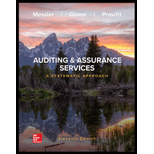
EBK AUDITING & ASSURANCE SERVICES: A SY
11th Edition
ISBN: 9781260687668
Author: Jr
Publisher: MCGRAW-HILL LEARNING SOLN.(CC)
expand_more
expand_more
format_list_bulleted
Question
Chapter 9, Problem 9.18MCQ
To determine
Concept Introduction:
Sampling is the method of selecting few items to check from the entire population under examination. Auditors apply sampling method while performing their
Sampling can be statistical or non statistical.
To choose: the correct statement about auditor’s use of statistical sampling.
Expert Solution & Answer
Want to see the full answer?
Check out a sample textbook solution
Students have asked these similar questions
I need help completing a chart with the following base on Amazon
What is the primary purpose of financial management?
A) Maximizing profits
B) Minimizing costs
C) Maximizing shareholder wealth
D) Managing liquidity need help!
What is the primary purpose of financial management?
A) Maximizing profits
B) Minimizing costs
C) Maximizing shareholder wealth
D) Managing liquidity
Chapter 9 Solutions
EBK AUDITING & ASSURANCE SERVICES: A SY
Ch. 9 - Prob. 9.1RQCh. 9 - Prob. 9.2RQCh. 9 - Prob. 9.3RQCh. 9 - Prob. 9.4RQCh. 9 - Prob. 9.5RQCh. 9 - Prob. 9.6RQCh. 9 - Prob. 9.7RQCh. 9 - Prob. 9.8RQCh. 9 - Prob. 9.9RQCh. 9 - Prob. 9.10RQ
Ch. 9 - Prob. 9.11MCQCh. 9 - Prob. 9.12MCQCh. 9 - Prob. 9.13MCQCh. 9 - Prob. 9.14MCQCh. 9 - Prob. 9.15MCQCh. 9 - Prob. 9.16MCQCh. 9 - Prob. 9.17MCQCh. 9 - Prob. 9.18MCQCh. 9 - Prob. 9.19MCQCh. 9 - Prob. 9.20MCQCh. 9 - Prob. 9.21PCh. 9 - Prob. 9.22PCh. 9 - Prob. 9.23PCh. 9 - Prob. 9.24PCh. 9 - Prob. 9.25PCh. 9 - Prob. 9.26P
Knowledge Booster
Similar questions
- The time value of money concept assumes that: A) A dollar today is worth more than a dollar tomorrow B) A dollar tomorrow is worth more than a dollar today C) Money has no time value D) Money grows at a fixed interest rate need answer.arrow_forwardThe time value of money concept assumes that: A) A dollar today is worth more than a dollar tomorrow B) A dollar tomorrow is worth more than a dollar today C) Money has no time value D) Money grows at a fixed interest ratearrow_forwardWhich option is correct? 19. In financial terms, liquidity refers to: A. Profitability of an investmentB. Ability to meet short-term obligationsC. Long-term solvencyD. Market value of equityarrow_forward
- The following data provides the monthly Comcast cable bill for a random sample of 20 households along with the number of televisions in the household (TV), the number of people living in the household (People), and the number of years that household has been a Comcast customer (Years). Bill TV People Years $56 1 3 8 $59 3 5 11 $67 3 2 3 $75 2 3 8 $76 4 1 8 $82 1 5 4 $84 3 3 3 $84 1 3 8 $84 4 4 4 $90 2 4 3 $91 3 5 5 $100 2 7 9 $100 2 2 5 $102 4 4 6 $104 3 5 10 $104 3 4 6 $112 4 3 2 $114 4 5 8 $130 5 5 1 $135 5 6 7 Develop a regression equation that will predict the monthly Comcast cable bill for a household based on the number of televisions in the household, the number of people living in the household, and the number of years that household has been a Comcast…arrow_forwardcan you provide correct answer for this question? If the Net Present Value (NPV) of a project is positive, it indicates: A. The project is unprofitableB. The project is financially viableC. The project has no riskD. The project will increase costsarrow_forwardI need correct answer for this question! If the Net Present Value (NPV) of a project is positive, it indicates: A. The project is unprofitableB. The project is financially viableC. The project has no riskD. The project will increase costsarrow_forward
- The market where new securities are issued and sold to investors is called: A. Secondary marketB. Money marketC. Primary marketD. Over-the-counter marketarrow_forwardA bond is trading at a premium when: A. Its coupon rate is equal to the yield to maturityB. Its market price is higher than its face valueC. Its market price is lower than its face valueD. It is issued by a well-rated companyarrow_forwardNeed help ! In financial terms, liquidity refers to: A. Profitability of an investmentB. Ability to meet short-term obligationsC. Long-term solvencyD. Market value of equity need answerarrow_forward
- In financial terms, liquidity refers to: A. Profitability of an investmentB. Ability to meet short-term obligationsC. Long-term solvencyD. Market value of equityarrow_forwardNeed help! Which type of risk cannot be eliminated through diversification? A. Market riskB. Credit riskC. Operational riskD. Unsystematic riskarrow_forwardWhich type of risk cannot be eliminated through diversification? A. Market riskB. Credit riskC. Operational riskD. Unsystematic riskarrow_forward
arrow_back_ios
SEE MORE QUESTIONS
arrow_forward_ios
Recommended textbooks for you
 Auditing: A Risk Based-Approach (MindTap Course L...AccountingISBN:9781337619455Author:Karla M Johnstone, Audrey A. Gramling, Larry E. RittenbergPublisher:Cengage Learning
Auditing: A Risk Based-Approach (MindTap Course L...AccountingISBN:9781337619455Author:Karla M Johnstone, Audrey A. Gramling, Larry E. RittenbergPublisher:Cengage Learning Auditing: A Risk Based-Approach to Conducting a Q...AccountingISBN:9781305080577Author:Karla M Johnstone, Audrey A. Gramling, Larry E. RittenbergPublisher:South-Western College Pub
Auditing: A Risk Based-Approach to Conducting a Q...AccountingISBN:9781305080577Author:Karla M Johnstone, Audrey A. Gramling, Larry E. RittenbergPublisher:South-Western College Pub

Auditing: A Risk Based-Approach (MindTap Course L...
Accounting
ISBN:9781337619455
Author:Karla M Johnstone, Audrey A. Gramling, Larry E. Rittenberg
Publisher:Cengage Learning

Auditing: A Risk Based-Approach to Conducting a Q...
Accounting
ISBN:9781305080577
Author:Karla M Johnstone, Audrey A. Gramling, Larry E. Rittenberg
Publisher:South-Western College Pub